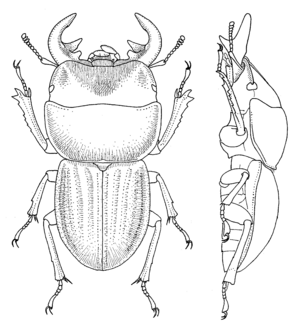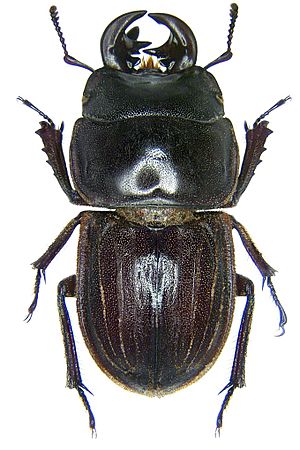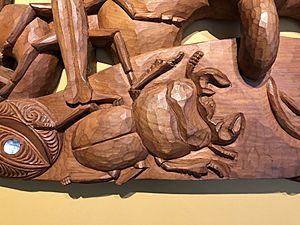Helms's stag beetle facts for kids
Quick facts for kids Helms's stag beetle |
|
|---|---|
 |
|
| Scientific classification | |
| Genus: |
Geodorcus
|
| Species: |
helmsi
|
| Synonyms | |
|
|
The Helms's stag beetle, also known by its scientific name Geodorcus helmsi, is a big, slow-moving beetle. It's a type of stag beetle that belongs to the Lucanidae family. This special beetle cannot fly, and it is found only in New Zealand. This means it is endemic to New Zealand, like a unique treasure found nowhere else!
Contents
About the Helms's Stag Beetle
Helms's stag beetles can be black or brownish-black. Their top surface can look dull or shiny. Like other stag beetles, males and females look different. This is called sexual dimorphism.
Male beetles are larger, measuring from 17.5 to 44.0 millimeters. This measurement includes their big mandibles, which are like strong jaws. Female beetles are smaller, from 16.5 to 27.5 millimeters. Their mandibles are not as noticeable.
Bigger male beetles have long, thin, and curved mandibles. They also have a clear tooth near the base of these mandibles. You can tell G. helmsi apart from other Geodorcus beetles because its lower legs (tibiae) are straight, not curved. It also has five ridges on its wing covers (elytra) that have bristles.
Where Helms's Stag Beetles Live
Geodorcus helmsi is the most common of the ten Geodorcus species. It has been found in many places across New Zealand. You can find it from Karamea on the northern West Coast of the South Island all the way down to Tapanui in West Otago.
These beetles have also been found on islands in Fiordland and on Stewart Island. Adult beetles live at many different heights, from sea level up to 1400 meters high.
Helms's Stag Beetle Habitat
All Geodorcus species are mostly active at night. During the day, they hide under fallen logs, stones, or leaf litter on the forest floor. At night, G. helmsi beetles have been seen moving on tree trunks. They chew on the bark to get to the sap that comes out.
These beetles live in many different kinds of places. This includes forests and high country areas covered in tussock grass.
What Helms's Stag Beetles Eat
Adult G. helmsi beetles have a varied diet because they live in many different habitats. These range from forests to tussock zones in the high country. Adults have been seen on tree trunks eating sap that leaks from wounds in the bark.
The larvae (young beetles) of other stag beetles often eat the surface of rotting wood. Geodorcus larvae have been found with a lot of humus (decayed plant and animal matter) inside their stomachs.
Life Cycle of the Helms's Stag Beetle
For New Zealand stag beetles, there isn't much published information about their life cycle. We don't know exactly how long they spend as eggs, larvae, pupae, or adults.
However, Geodorcus larvae have been seen living under decaying logs. They make tunnels in the soil layer. These larvae are "C" shaped, move slowly, and try to avoid light.
Protecting Helms's Stag Beetles
All Geodorcus species are protected by law under Schedule 7 of The 1953 Wildlife Act. This means it is against the law to hunt, kill, or even own one of these beetles.
Introduced rats have caused the number of G. helmsi beetles to go down. On islands where rats are present, only the remains of these beetles can be found. Also, this species has been found to make up a large part of the food eaten by wild pigs.
See also
 In Spanish: Geodorcus helmsi para niños
In Spanish: Geodorcus helmsi para niños





